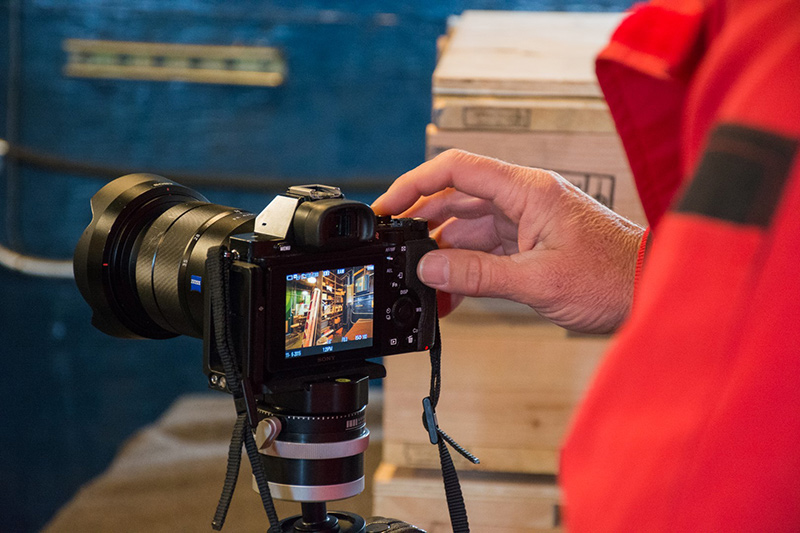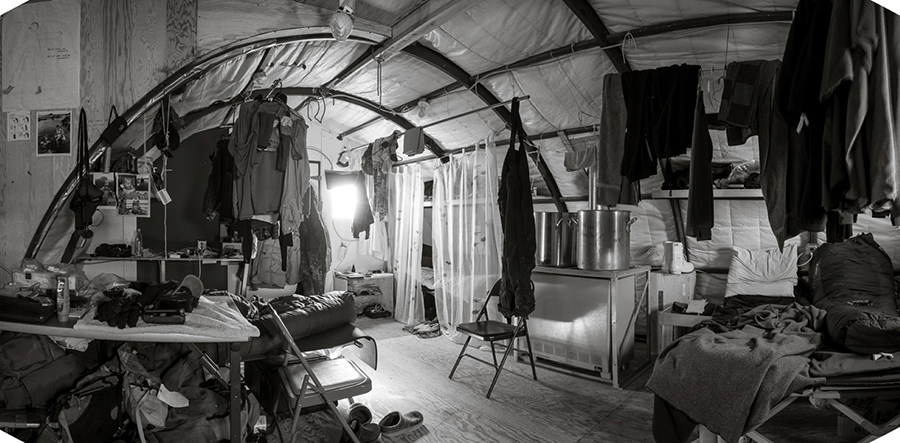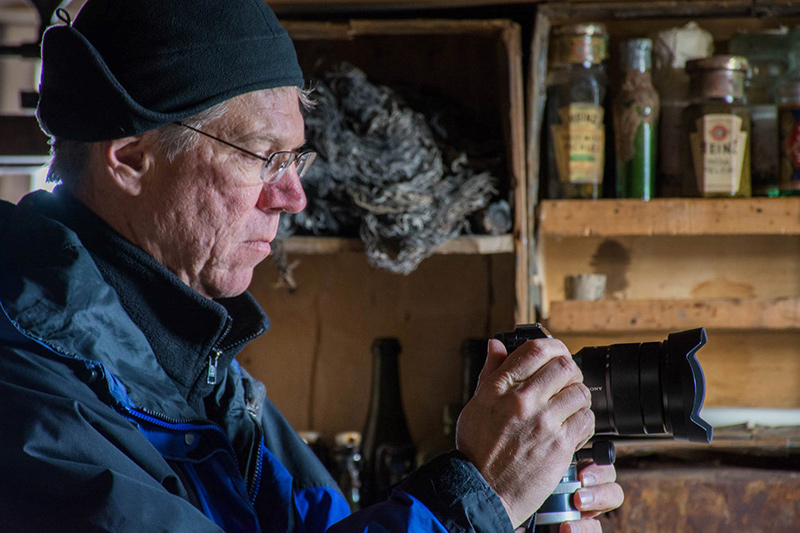The Aesthetics of Antarctic ArchitectureA photographer captures the utilitarian charm of McMurdo StationPosted April 28, 2016
The current aesthetics of McMurdo station and its field camps are not likely to go down in history as great achievements of modern architecture. 
Photo Credit: Mike Lucibella
O’Boyle snaps a photo of the CosRay experiment, the longest continuously running experiment at McMurdo Station.
Aside from the Crary Lab and the Science Support Center, the structures around town are largely a hodgepodge of midcentury U.S. Navy construction and well-worn, prefabricated buildings. The field camps are mostly old military-style tents and small, boxy plywood creations. They’re functional, built to survive against the harsh Antarctic elements, not for looks. But for Photographer Shaun O’Boyle “I’m interested in places where landscapes and communities show their origins and history through architecture and infrastructure,” O’Boyle said. 
Photo Credit: Shaun O’Boyle
O’Boyle’s keen eye for the camera brings out the aesthetics of Building 137 and how it interacts with its landscape.
As one of the season’s Artists and Writers, he spent six weeks around the continent documenting McMurdo Station, its nearby field camps and the historic huts that date back more than 100 years. His trip to Antarctica was supported by the National Science Foundation, which manages the U.S. Antarctic Program. Back home, O’Boyle works at an architecture firm in Dalton Massachusetts, doing architectural design and photography, graphic design work and developing their website. Outside of the office, he fuses this interest in architecture and design by exploring and photographing old, often abandoned industrial sites around the region. “These places have unique stories to tell, the landscape can be read to a degree, there are narratives contained in the land forms and old buildings which tell stories that are outside the usual telling of history,” O’Boyle said. He’s visited sites like the shuttered Bethlehem Steel mill in Bethlehem Pennsylvania, an abandoned asylum in Northampton Massachusetts, defunct launch pads at Kennedy Space Center in Florida and a still-active paper mill in Turners Falls Massachusetts. Through his photographs, he seeks to capture a sense of history about the structures he’s visiting. “I’ve always been drawn to ruins, in particular industrial and other large scale ruins,” O’Boyle said. “That sort of scale of architecture and infrastructure form part of the American landscape, shaped by the industrial buildup during and after the world wars.” It was this kind of a physical connection to history that first piqued his interest in Antarctica. “It was the [historic] huts that attracted me first,” O’Boyle said. “I became interested in the other architecture down here as well. The stations, what the field camps would look like [and] how these places operate was pretty much a big unknown to me before I came down here.” 
Photo Credit: Michael Lucibella
The historic huts around Ross Island were of particular interest to O’Boyle.
Around Ross Island, where McMurdo Station is situated, there are three historic huts once used by many of the famous explorers of the heroic age of exploration, including Robert Falcon Scott and Ernest Shackleton. They’ve been preserved as historic sites with all of their artifacts in nearly the same condition that the old explorers left them. These huts were the jumping-off points for some of the most daring, and often times tragic, Antarctic expeditions in the early 20th century. But they were also the sites of some of the earliest research into the geology and biology of the frozen continent. “The historic huts are very small, yet the early expeditions did a lot of science out of those huts,” O’Boyle said. “Today’s field camps are on a similar scale and they’re doing amazing science out of these structures. That was one parallel I wanted to look at.” O’Boyle hopped around the region, making stops at numerous historic sites as well as active camps full of researchers conducting science, often combining the two on a single trip. 
Photo Credit: Shaun O’Boyle
O’Boyle draws out the personality of utilitarian remote sites like the field camp at New Harbor.
In November he spent nine days throughout the Taylor Valley documenting the modern field camps at New Harbor, Lake Hoare, Lake Bonney and Lake Fryxell. At the same time he hiked throughout the valley, roughly following the routes that the explorers Robert Falcon Scott, Griffith Taylor and Frank Debenham took more than 100 years ago. “I was interested in seeing how the landscape unfolded from their perspective, when it was seen for the first time,” O’Boyle said. “I made an attempt to take photographs from a few of the locations that they sketched from.” After returning from the Dry Valleys, he had a particularly harrowing excursion to Wilson’s stone igloo, near Cape Crozier. Now not much more than a few mounds of stones, it was built in the winter of 1911 when a team led by Edward Wilson sought to recover the first emperor penguin eggs. In it the team weathered a hurricane-force blizzard that blew their tents away, leaving them only their sleeping bags for protection against the storm. “When we arrived it was fairly calm,” O’Boyle said. He and his companions stepped off their helicopter and started looking for the low-lying stone piles that remained of the igloo. It wasn’t easy to find, the area was still partially covered in snow and the igloo’s stones blended in with the landscape. Once they located the ruins, O’Boyle quickly set about capturing the lay of the land. “Then within 20 minutes the wind was blowing at about 30 knots or so and we had to bail out,” O’Boyle said. “It was enough time to see it and photograph it… it was an adventure, but I got what I needed out of it.” O’Boyle also visited the historic huts at Cape Evans and Cape Royds, the latter of which is also the site of a field camp with researchers studying the nearby penguin colony. Between trips, he spent time photographing the buildings of McMurdo Station, the central hub that coordinates and supplies all of the field camps. Plans are in the works to rebuild many of the structures at McMurdo in the coming years, and O’Boyle helped to document the station as it exists today. “I spent time in a lot of the buildings because the station is going to be redesigned, visiting some of the places that are unique and have been occupied for many years, like the [Berg Field Center], the paint shack, the church, and the coffee shop,” O’Boyle said. “Those kinds of spaces are really interesting to me because they have been personalized by the people who use the space.” Since returning to the United States, O’Boyle has been sifting through and editing the thousands of photos he took on the frozen continent. He’s selecting the best for an exhibition of his work at the Berkshire Museum in Pittsfield Massachusetts opening in January of next year. In addition, he’s drafting a companion book of his photos to go along with the exhibition. “It’s been an amazing experience, hugely rewarding, the scope of the program and the level of the science happening was way beyond what I was expecting,” O’Boyle said. NSF-supported research in this article: Shaun O’Boyle, Award No. 1444805 |
"News about the USAP, the Ice, and the People"



For USAP Participants |
For The Public |
For Researchers and EducatorsContact UsU.S. National Science FoundationOffice of Polar Programs Geosciences Directorate 2415 Eisenhower Avenue, Suite W7100 Alexandria, VA 22314 Sign up for the NSF Office of Polar Programs newsletter and events. Feedback Form |


